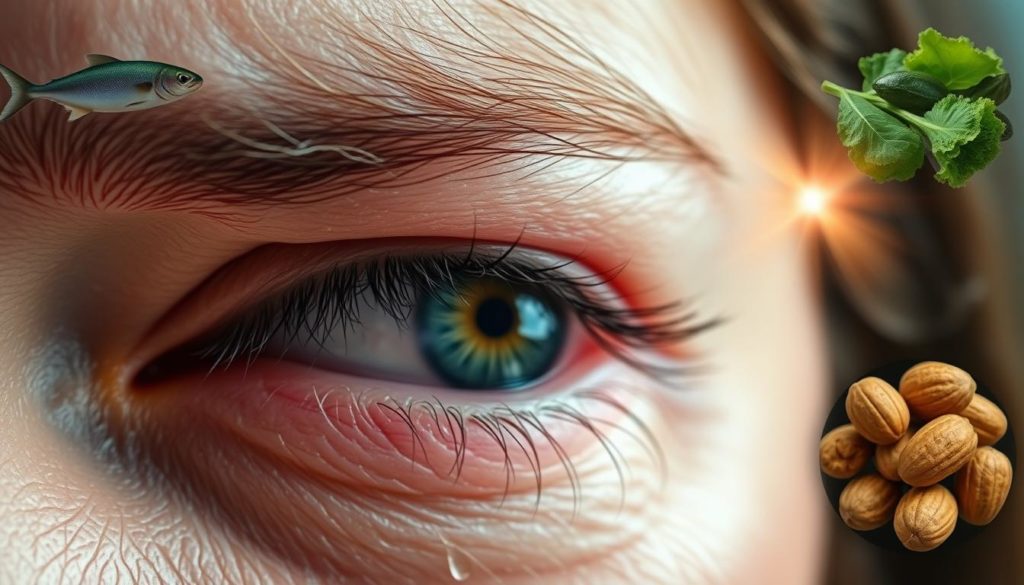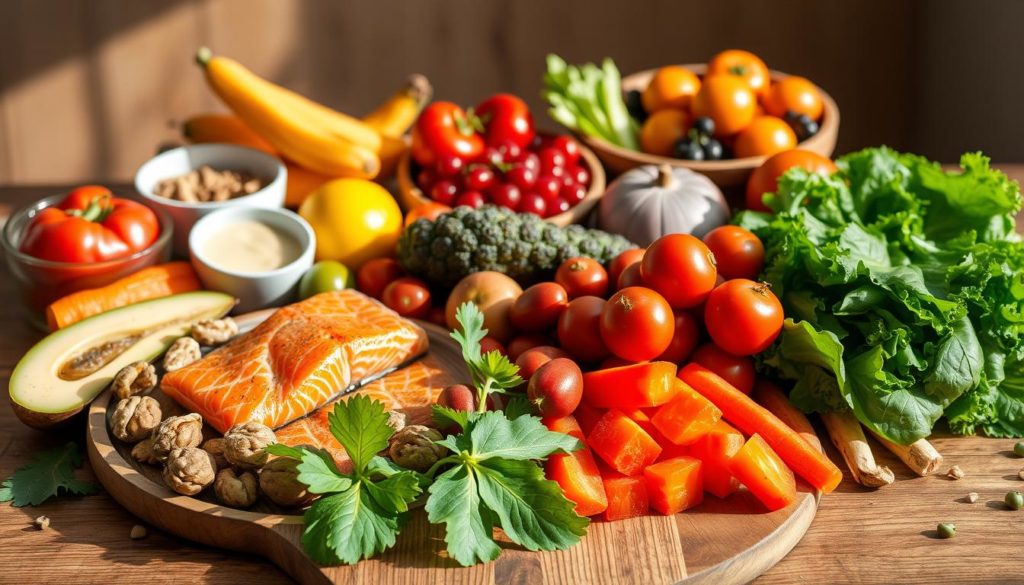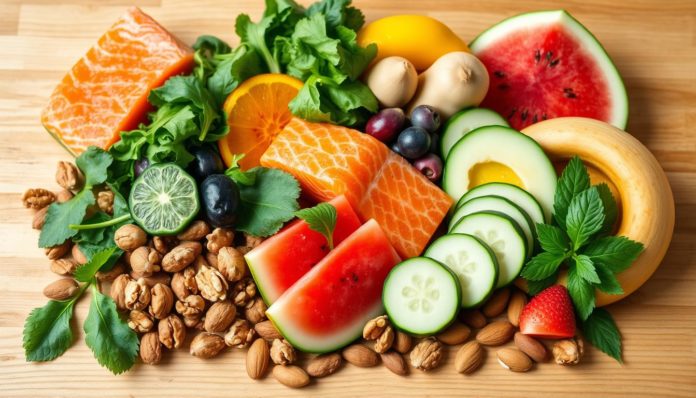Did you know about 16 million Americans deal with dry eye syndrome? This common issue can greatly affect your daily activities. By following a dry eye diet, you might find significant relief. The right foods can help ease symptoms and boost your vision health.
Fish, rich in omega-3 fatty acids, can lessen eye inflammation. Leafy greens filled with Vitamin C fight off damage from aging. Also, seeds and nuts offer omega-3 and Vitamin E, supporting tear repair. Adding these foods to your daily diet can work better than supplements alone. Let’s explore the top foods that can help with dry eye and improve eye wellness.
Understanding Dry Eye Syndrome and Its Causes
Dry eye syndrome affects over 16 million Americans. It is a chronic condition that needs continuous care. Understanding the causes and realizing the importance of nutrition for eye health are crucial steps.

Many factors lead to dry eye syndrome. Chronic inflammation on the eye’s surface plays a big role. It disturbs tear production and stability. Lifestyle and environment, like screen use and climate, also worsen it. Hormone changes and some meds can increase dry eye risks.
Eating well helps manage dry eye syndrome. A diet full of vitamins and minerals eases symptoms and boosts eye health. Omega-3 fatty acids are especially good. They fight inflammation and help make more tears. Fatty fish and flaxseeds are great sources.
| Nutrient | Benefits | Sources |
|---|---|---|
| Omega-3 Fatty Acids | Reduces inflammation, enhances tear production | Fatty fish, flaxseeds |
| Vitamin A | Improves tear film quality | Carrots, sweet potatoes |
| Vitamin C | Protects ocular surface | Citrus fruits, bell peppers |
| Vitamin E | Prevents damage from free radicals | Nuts, seeds |
Choosing foods that improve nutrition for eye health helps with dry eye syndrome. It shows how our diet is closely linked to eye health.
The Importance of Nutrition for Eye Health
Eating well is key for your whole body, including your eyes. A healthy diet for dry eyes can ease symptoms and improve your vision. Foods rich in omega-3 fatty acids, vitamins C and E, and minerals like zinc, help fight dry eye and keep your eyes healthy.
Omega-3 fatty acids are in fish and flaxseeds. They help the meibomian glands work right. These glands make quality tears. So, foods for dry eyes keep your eyes moist and comfy.
Antioxidants like Vitamin C and E shield your eyes from harm. Food such as citrus fruits, almonds, and spinach carry these vitamins. They lower the chance of eye diseases. Plus, they help keep your eye cells healthy, ensuring your vision stays sharp.

| Nutrient | Benefits | Food Sources |
|---|---|---|
| Omega-3 Fatty Acids | Improves tear quality | Fish, Flaxseeds |
| Vitamin C | Reduces oxidative stress | Citrus Fruits, Berries |
| Vitamin E | Protects eye cells | Almonds, Spinach |
| Zinc | Supports immune function | Meat, Shellfish |
A healthy diet for dry eyes benefits your eye health and your overall wellness. Including these nutrients in your diet is a smart choice.
Benefits of Omega-3 Fatty Acids
Omega-3 fatty acids are famous for their health benefits, including fighting inflammation. They are key in keeping our eyes healthy, specifically in easing dry eyes. Let’s dive into the main sources of omega-3s and see how they help with dry eyes.
Sources of Omega-3 Fatty Acids
To get enough omega-3s, eat foods rich in these nutrients. The top sources are:
- Fatty fish like salmon, mackerel, and sardines
- Nuts, especially walnuts
- Seeds like flaxseeds and chia seeds
- Oils such as flaxseed oil and fish oil
| Food Source | Omega-3 Content (mg per serving) |
|---|---|
| Salmon | 1,800 |
| Chia Seeds | 5,000 |
| Walnuts | 2,500 |
| Flaxseed Oil | 7,200 |
How Omega-3s Help Dry Eyes
Omega-3s are great for people with dry eyes. They improve meibomian gland function, which makes oils for our tears. These oils help our tears evaporate slower and calm dry eye symptoms. Adding omega-3 rich foods to our meals supports this gland.
Aside from food, taking high-quality omega-3 supplements helps reach the 2000 mg daily goal. Choose supplements with EPA, DHA, and GLA. They fight eye inflammation and boost the benefits of omega-3 for dry eyes.
Incorporating Leafy Greens into Your Diet
Leafy greens are key for keeping your eyes healthy. They have important nutrients that prevent vision problems. Adding these greens to your meals helps your eyes stay in good shape.
Key Nutrients in Leafy Greens
Leafy greens have nutrients that are essential for eye health. These include:
- Vitamin C: An antioxidant that guards your eyes against damage and aging.
- Folate: It helps prevent vision loss and keeps your eyes healthy.
- Lutein and Zeaxanthin: Antioxidants that shield your eyes from harmful light and boost vision.
Best Leafy Greens for Eye Health
Eating different leafy greens can greatly benefit your eye health. The top picks for relief include:
| Leafy Green | Key Nutrients |
|---|---|
| Kale | Vitamin C, Lutein, Zeaxanthin |
| Spinach | Folate, Vitamin C, Lutein |
| Collard Greens | Folate, Vitamin C |
| Broccoli | Vitamin C, Lutein |
| Swiss Chard | Vitamin C, Folate |
Eating these greens regularly gives your body important vitamins for eye health. They also help keep your eyes hydrated and reduce strain. Make these foods part of your diet to support good vision and fight issues like dry eyes.
Boosting Eye Health with Nuts and Seeds
Eating the right foods is crucial for keeping our eyes healthy. Nuts and seeds are great for anyone with dry eye problems. They are key to a diet that keeps our eyes in good shape, as noted on the American Academy of Ophthalmology site.
Types of Nuts and Seeds
Many nuts and seeds are full of eye-friendly nutrients. Here’s a list of some important ones:
- Walnuts
- Cashews
- Peanuts (Technically legumes)
- Flaxseeds
- Chia seeds
Essential Nutrients Found in Nuts and Seeds
Nuts and seeds are packed with nutrients good for the eyes. Here’s what they contain:
- Omega-3 fatty acids: Lots in walnuts, flaxseeds, and chia seeds. Omega-3s help make more tears to keep eyes moist.
- Vitamin E: Found in almonds and peanuts. Vitamin E protects our eyes from damage.
- Zinc: A lot in cashews. Zinc helps us see well as we get older.
Adding these foods to your diet is great for making more tears and protecting your eyes. Flaxseed and chia seeds are also great for people who don’t eat meat or animal products. They help keep everyone’s eyes healthy.
Hydration: The Role of Water in Relieving Dry Eye
Keeping your eyes moist is key, which means staying hydrated is a must. Water helps maintain eye health by supporting tear production. This prevents dry eyes. Dry eye disease (DED) can be eased by avoiding dehydration.
Hot and dry climates increase the risk of dry eyes. This makes it crucial to drink enough water. Aim for 64 oz a day to keep your body and eyes hydrated.
Recent studies have raised questions about water intake and dry eyes. There is a belief that drinking lots of water may affect dry eye disease. More research is needed to understand this link. However, it’s clear that being well-hydrated is essential for health.
Vitamin C: Why It’s Crucial for Eye Health
Vitamin C is key to keeping our eyes healthy. It helps the blood vessels in our eyes work well. It also plays a part in staving off issues like cataracts. For dry eyes too, vitamin C is important. It fights oxidative stress on the eye surface. Plus, it helps keep the cornea and other connective tissues strong.
Top Vitamin C Rich Foods
You can find vitamin C in many foods to add to your meals:
- Citrus fruits (oranges, lemons, grapefruits)
- Leafy greens (spinach, kale)
- Bell peppers
- Strawberries
- Broccoli
- Kiwi
Eating these foods helps you meet your vitamin C needs every day. Women need 75 mg and men need 90 mg daily.
Effects of Vitamin C on Dry Eyes
Vitamin C, or ascorbic acid, does wonders for eye health. It can greatly ease dry eye symptoms. This antioxidant lowers inflammation and takes care of the cornea. So, getting enough vitamin C from food or supplements is a good way to treat dry eyes.
Vitamin E: Protect Your Eyes from Damage
Vitamin E is a strong antioxidant that shields your eyes from damage. It’s vital to include foods high in vitamin E in your daily meals for eye health. This nutrient boosts your immune system and protects eye cells from free radicals.
Sources of Vitamin E
To get enough vitamin E for dry eyes, add various antioxidant-rich foods to your diet. Sunflower seeds, almonds, spinach, and peanuts are packed with vitamin E. These natural sources are better than supplements at increasing your vitamin E levels.
Benefits of Vitamin E for Dry Eye Relief
Eating vitamin E-rich foods supports the tear film, keeping your eyes moist. It also protects cells, lessening dry eye symptoms. Vitamin E fights oxidative stress, improving overall eye health and easing dry eye discomfort.
FAQ
What is the best dry eye diet?
The top diet for dry eyes has lots of omega-3s. Think fish, nuts, and seeds. It also includes leafy greens loaded with Vitamin C. And don’t forget to drink plenty of water to stay hydrated.
How does omega-3 help with dry eyes?
Omega-3 fatty acids fight inflammation on the eye’s surface. They aid in gland function and enhance tear quality. This stabilizes the tear layer, cutting down on tear loss.
What are good sources of omega-3 for dry eyes?
Great omega-3 sources are fatty fish like salmon, and nuts such as walnuts. Seeds like flaxseeds and chia seeds are good too. Also, consider flaxseed oil and fish oil, aiming for a 2000 mg daily intake.
Which leafy greens are beneficial for dry eyes?
Kale, spinach, collards, and broccoli are packed with Vitamin C and other antioxidants. They shield eyes and prevent damage as we age.
How do nuts and seeds improve eye health?
Nuts like almonds and walnuts, along with seeds such as flaxseeds and chia seeds, are rich in omega-3s and Vitamin E. They help make more tears and fight off eye stress.
What role does hydration play in alleviating dry eye symptoms?
Staying well-hydrated is key to combating dry eyes. Aim to drink at least 64 oz of water a day. It helps keep tear production up and eyes healthy.
Why is Vitamin C important for eye health?
Vitamin C is vital for the eye’s blood vessels, wards off cataracts, reduces stress, and keeps connective tissues in shape. You can find it in citrus fruits, leafy greens, and some juices.
Which foods are rich in Vitamin C?
For a big Vitamin C boost, go for citrus fruits, leafy greens, berries, and certain juices. Oranges, lemons, spinach, and kale are fantastic choices.
How does Vitamin E benefit dry eyes?
Vitamin E acts as an antioxidant, guarding eye cells and boosting the immune system. Foods like sunflower seeds, almonds, and peanuts are very beneficial. They help keep the tear film and eyes in good shape.
What are the dietary sources of Vitamin E?
Good sources of Vitamin E include sunflower seeds, almonds, peanuts, and vegetable oils. Think sunflower oil and safflower oil for your diet.


